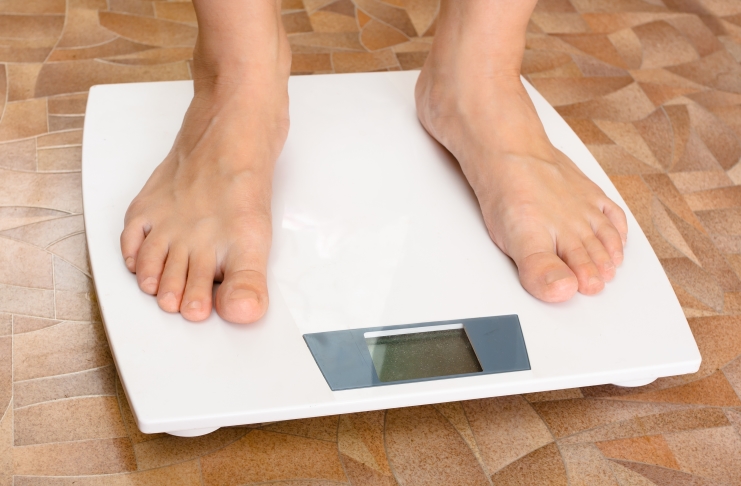Digital bathroom scales have come way down in price over the last few years.
What was once considered a luxury has now become essential to tech savvy users who want the best accuracy possible, while being able to read their weight and other BMI measurements comfortably from home, and connect to their apps via their Internet router or smart devices.
Digital scales have certainly come down in price, but the quality you receive in return is far and above what you would have been buying as little as three years ago.
3 Benefits of Owning a Digital Bathroom Scale
1. Convenience
Outside of home, there are very few places one can weigh themselves. You could use the scale at your local gym, but that can be embarrassing to most people who don’t want the whole gym knowing how much they weigh.
There’s also the doctor’s office, but few doctors would appreciate you taking up their time just to get yourself weighed (not to mention the cost to you). When you own your own scale, you can weigh yourself as often as you like.
2. Durability
The benefit of durability relates to the difference between digital scale technology and the old analog style bathroom scales that are now considered by most to be dated and inaccurate.
The strain gauge technology used as the weighing mechanism in digital scales can last virtually forever when cared for. Compare this to the springs used to measure weight on an analog scale, which are inaccurate right out of the box, and continue to deteriorate quickly each time they’re used.
3. Accuracy/Consistency
A quality digital bathroom scale will give you the same reading several times in a row. This compared to traditional analog models which are a constant source of complaint from users due to the fact they never give you the same measurement twice.
Strain gauges are very accurate and have been around and continuously refined since the late 1930s.
Digital vs Analog vs Counter Balance Scales
Digital
Digital bathroom scales use a device called a strain gauge which can last virtually forever if the scale’s not abused. When a user steps on the platform to weigh themselves, the platform bends a series of thin, metallic strands of electric conductive foil, embedded within an adhesive material that’s very similar in appearance to thick scotch tape – this is the basic design of a strain gauge. As this apparatus is bent under weight, its conductive ability is predictably changed, resulting in an extremely accurate measurement of the load that’s bending it.
Modern improvements to the strain gauge’s design have made it impervious to differences in the Earth’s gravity between different regions, and also unaffected by temperature and humidity; though poorly made (ie., cheap) strain gauges can be affected by humidity if the conductive foil isn’t completely insulated from the ambient air by the protective adhesive material.
Though they’re much more simple in operation than both an analog or counter balance scale, digital relies on battery power in order to give a readout. While this could be called a drawback, most quality digital bathroom scales use 3 or 4 AAA batteries which are easy to find in long-lasting lithium or even rechargeable versions. Even with constant use, one can expect anywhere from 2 – 5 years of operation before the battery fails – quality is obviously a factor in how long the battery lasts.
Practical, lasting and affordable:
While it’s debatable whether digital bathroom scales are more accurate than counter balance scales or not; they’re certainly accurate enough to give dependable results within a pound or two of your true bodyweight.
Digital designs are more accurate under all environmental conditions when compared to analog, are more consistent, and the strain gauge’s design means it never has to be calibrated by the user.
Analog
Analog scales measure bodyweight using a spring that when compressed, forces the gauge on the readout to give a weight measurement. The spring will invariably wear the more it’s used and experienced users know all to well that these devices often need to be “zeroed out” using an adjustment dial quite frequently throughout the lifespan of the scale.
While there’s often strength and accuracy that come with a simple design such as this, analog scales suffer from a few known accuracy issues:
• The spring often doesn’t compress at exactly the same rate every time, even when the same user steps on the scale within a short time period. Sometimes the variance can be as much as 5 pounds in either direction.
• Spring compression rate varies significantly by location, as different gravitational forces exist throughout the planet, resulting in different measurements.
• Spring compression rate is significantly affected by ambient temperatures, meaning major temperature fluctuations can result in vastly different readings from one day to the next even if your weight remains the same.
Not the best option if accuracy is desired:
While analog scales have been vastly popular for decades now, technology has caught up with them. Analog scales require more maintenance in the form of frequent adjustments needed, accuracy can be affected by both location and ambient temperature, and the spring mechanism will always invariably fail.
It’s possible to consider them accurate when new, but how long that accuracy remains can only be determined by testing them frequently with a known, laboratory-verified weight. Not to mention that the price difference between this type and a quality digital scale isn’t very much at all, even though price difference was an issue leading up to the last few years.
Counter Balance
May also be called “mechanical balance” or “beam balance.” Counter balance bodyweight scales are much more complex in their design than either mentioned so far. They consist of several parts including a weighing pan to stand on, levers, pivot points, and a beam with one or two precision-made counter balance weights that slide along the beam to give the user their exact weight.
As torque is applied to the platform by placing a weight to be measured on it, that torque transfers to the levers which are then “counter balanced” on the beam to determine the gravitational force (in this case weight) exerted on it by the user. Counter balance weigh scales are very accurate and rarely, if ever, require calibration for home users. This type of scale is used by laboratories and sporting organizations like MMA and boxing to weigh participants.
Impractical for home users:
Because of their precision design and the extensive parts needed, counter balance scales are expensive for home users to buy, and require a fair bit of space be afforded in your home for them to be setup and used. Also, taking this device apart and storing it isn’t practical for most home users wanting to weigh themselves occasionally.
What to Look for Before Purchasing a Digital Bathroom Scale
Weight Capacity
This might seem like an obvious, but it’s an issue that often affects overweight people who’re buying a scale to help them track their weight loss. Scales typically top out at 300 – 500 pounds. While 300 is perfectly fine for most users, if you exceed the scale’s weight capacity, it’ll be useless to you until you get your weight down to below it’s rated capacity.
Platform Size
Balance can be a real issue when a few different factors come into play. If you’re a large person (stocky build, tall – all the above), have large feet, or just find it hard to balance when not standing on flat ground, you’ll want to make sure the scale you’re buying has an extra large platform to stand on. Cheap digital scales will offer a 9 or 10-inch platform, which is hard for most people to balance on. Higher end versions will have12 – 15 inch platforms.
Display
Some displays come without a back light, which can make it hard to read in all but the best lighting scenarios, particularly low light conditions. Reading reviews and looking at pictures of the product should be sufficient to determine if the display is easy to read or not. Look for a minimum 3-inch display.
Measurement Increments
Look for a scale that offers measurement increments of no more than 0.5 pounds. Better units will go as low as 0.2 pound increments. If this information isn’t available on the box or product description, look for “Minimum Weight” which lists the minimum weight the scale can measure. Good scales will list their minimum as 0.2 – 0.5 pounds.
Step-On Technology
Traditional digital bathroom scales require you to tap the platform with your foot, then wait up to 10-seconds before stepping on the scale to weigh yourself. This can get frustrating when you combine the fact that many of these devices also time out and shut off in less than 10-seconds once they’re ready, meaning you have to step on the scale before it auto shuts off. Step on technology means the scale turns on when you’re ready and gives you a weight readout shortly thereafter – no hairpin timing required to use!
Mode Options
Mode options allow you to select different units of measure: ie., pounds, kilograms, stone, etc. This is an option that won’t apply to everyone. However, if you’re a competitive international athlete, or someone who just likes to see different units of measure without having to convert, this is an option to look for.
Wireless Connectivity
If you plan on syncing your weight with your smartphone or uploading/tracking your weight and bodyfat changes via an online app such as Fitbit or EatSmart, you’ll want to choose either a proprietary scale made by your favorite app provider, or make sure that the scale you’re buying is able to sync with your smartphone and/or wireless router.
Body Composition Measurements
One of the more exciting features to come out in the area of digital bathroom scales is the ability to go beyond simple bodyweight measurements and get more information about your body mass index (BMI).
Spending a few dollars more on a quality scale gives you the ability to measure your water weight and bodyfat measurements using bioelectrical impedance analysis (BIA). BIA works by applying an imperceptible electrical charge through your body and measuring the resistance. Though not as accurate as hydrostatic weighing, this is still very helpful for people seeking to lose bodyfat.
Memory Capacity
If you’re a little more old school than most and don’t like tracking and storing everything in your smartphone or in the cloud, looking for a unit with enough memory to hold your weight and other BMI data might be important to you. Manufacturers don’t list how much on-board memory their scales hold, but in general, if the scale claims to store data for more than one user, it’s likely to have enough memory to store all your measurements.
Battery Life
It’s hard to gauge how long batteries will last in a scale without reading reviews and not buying the latest and greatest devices until a number of other “guinea pigs” have used a given scale for a while. In general, the smaller the battery, the less drain the scale and its features (such as display and BIA) have on the battery.
However, selecting a scale that runs on small button cell batteries to save battery life and potential battery expense (if not using rechargeable versions) will limit the options offered on the scale such as a high-res backlit display, BMI measurements and WiFi connectivity. Consider using rechargeable batteries or pricier lithium-ion batteries to offset the decreased battery life of higher-end units with more features.
Summary
In the sea of choices available, you might find it difficult to settle on one model over the other. The main takeaway for anyone looking for a way to measure and track their weight and other BMI data easily from home, is that digital technology is the only smart choice when considering factors such as accuracy, features, smart device syncing, and overall value.
A good counter balance scale will certainly give you readings that are just as accurate as most digital models. However, they cost hundreds of dollars to purchase and take up a considerable amount of space in your home. Analog scales, as you’ve learned, are considered so inaccurate and prone to wear, it just doesn’t make sense to spend your money on them.
We hope we’ve made the choice to buy a digital bathroom scale as easy as possible for you today. Thanks for stopping in!




